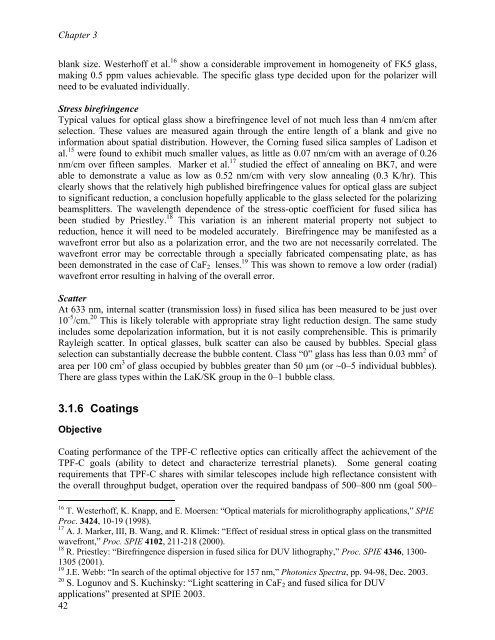TPF-C Technology Plan - Exoplanet Exploration Program - NASA
TPF-C Technology Plan - Exoplanet Exploration Program - NASA
TPF-C Technology Plan - Exoplanet Exploration Program - NASA
Create successful ePaper yourself
Turn your PDF publications into a flip-book with our unique Google optimized e-Paper software.
Chapter 3<br />
blank size. Westerhoff et al. 16 show a considerable improvement in homogeneity of FK5 glass,<br />
making 0.5 ppm values achievable. The specific glass type decided upon for the polarizer will<br />
need to be evaluated individually.<br />
Stress birefringence<br />
Typical values for optical glass show a birefringence level of not much less than 4 nm/cm after<br />
selection. These values are measured again through the entire length of a blank and give no<br />
information about spatial distribution. However, the Corning fused silica samples of Ladison et<br />
al. 15 were found to exhibit much smaller values, as little as 0.07 nm/cm with an average of 0.26<br />
nm/cm over fifteen samples. Marker et al. 17 studied the effect of annealing on BK7, and were<br />
able to demonstrate a value as low as 0.52 nm/cm with very slow annealing (0.3 K/hr). This<br />
clearly shows that the relatively high published birefringence values for optical glass are subject<br />
to significant reduction, a conclusion hopefully applicable to the glass selected for the polarizing<br />
beamsplitters. The wavelength dependence of the stress-optic coefficient for fused silica has<br />
been studied by Priestley. 18 This variation is an inherent material property not subject to<br />
reduction, hence it will need to be modeled accurately. Birefringence may be manifested as a<br />
wavefront error but also as a polarization error, and the two are not necessarily correlated. The<br />
wavefront error may be correctable through a specially fabricated compensating plate, as has<br />
been demonstrated in the case of CaF 2 lenses. 19 This was shown to remove a low order (radial)<br />
wavefront error resulting in halving of the overall error.<br />
Scatter<br />
At 633 nm, internal scatter (transmission loss) in fused silica has been measured to be just over<br />
10 -5 /cm. 20 This is likely tolerable with appropriate stray light reduction design. The same study<br />
includes some depolarization information, but it is not easily comprehensible. This is primarily<br />
Rayleigh scatter. In optical glasses, bulk scatter can also be caused by bubbles. Special glass<br />
selection can substantially decrease the bubble content. Class “0” glass has less than 0.03 mm 2 of<br />
area per 100 cm 3 of glass occupied by bubbles greater than 50 μm (or ~0–5 individual bubbles).<br />
There are glass types within the LaK/SK group in the 0–1 bubble class.<br />
3.1.6 Coatings<br />
Objective<br />
Coating performance of the <strong>TPF</strong>-C reflective optics can critically affect the achievement of the<br />
<strong>TPF</strong>-C goals (ability to detect and characterize terrestrial planets). Some general coating<br />
requirements that <strong>TPF</strong>-C shares with similar telescopes include high reflectance consistent with<br />
the overall throughput budget, operation over the required bandpass of 500–800 nm (goal 500–<br />
16 T. Westerhoff, K. Knapp, and E. Moersen: “Optical materials for microlithography applications,” SPIE<br />
Proc. 3424, 10-19 (1998).<br />
17 A. J. Marker, III, B. Wang, and R. Klimek: “Effect of residual stress in optical glass on the transmitted<br />
wavefront,” Proc. SPIE 4102, 211-218 (2000).<br />
18 R. Priestley: “Birefringence dispersion in fused silica for DUV lithography,” Proc. SPIE 4346, 1300-<br />
1305 (2001).<br />
19 J.E. Webb: “In search of the optimal objective for 157 nm,” Photonics Spectra, pp. 94-98, Dec. 2003.<br />
20<br />
S. Logunov and S. Kuchinsky: “Light scattering in CaF 2 and fused silica for DUV<br />
applications” presented at SPIE 2003.<br />
42
















